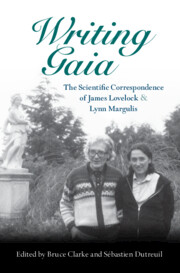Book contents
- Writing Gaia: The Scientific Correspondence of James Lovelock and Lynn Margulis
- Reviews
- Writing Gaia: The Scientific Correspondence of James Lovelock and Lynn Margulis
- Copyright page
- Epigraph
- Table of Contents
- Figures
- Contributors
- Foreword by James Lovelock
- Preface
- Acknowledgements
- Introduction
- Part I 1970–1972
- Part II 1973–1979
- Part III 1980–1991
- Part IV 1992–2007
- Part V Commentaries on Lovelock and Margulis
- Darwinizing Gaia
- Gaia at the Margulis Lab
- Gaia and the Water of Life
- Gaia as a Problem of Social Theory
- Befriending Gaia: My Early Correspondence with Jim Lovelock
- Gaia’s Pervasive Influence
- Gaia’s Microbiome
- Tangled Up in Gaia
- Lovelock and Margulis
- Discovering Geology, Discovering Gaia
- Glossary of Names
- Glossary of Terms
- Bibliography
- Index
Tangled Up in Gaia
from Part V - Commentaries on Lovelock and Margulis
Published online by Cambridge University Press: 28 July 2022
- Writing Gaia: The Scientific Correspondence of James Lovelock and Lynn Margulis
- Reviews
- Writing Gaia: The Scientific Correspondence of James Lovelock and Lynn Margulis
- Copyright page
- Epigraph
- Table of Contents
- Figures
- Contributors
- Foreword by James Lovelock
- Preface
- Acknowledgements
- Introduction
- Part I 1970–1972
- Part II 1973–1979
- Part III 1980–1991
- Part IV 1992–2007
- Part V Commentaries on Lovelock and Margulis
- Darwinizing Gaia
- Gaia at the Margulis Lab
- Gaia and the Water of Life
- Gaia as a Problem of Social Theory
- Befriending Gaia: My Early Correspondence with Jim Lovelock
- Gaia’s Pervasive Influence
- Gaia’s Microbiome
- Tangled Up in Gaia
- Lovelock and Margulis
- Discovering Geology, Discovering Gaia
- Glossary of Names
- Glossary of Terms
- Bibliography
- Index
Summary
My first wide-eyed jolt from a comment by Lynn Margulis came in a 1977 issue of CoEvolution Quarterly on space exploration. Given a question about whether we should be trying to establish colonies in space, she cut to the chase: when a biological species is able to move into a new environment, it will do so. End of debate! Margulis appeared in those pages often, as professional biologist and big thinker. I read her book, Origin of Eukaryotic Cells, several years prior to entering graduate school. Two decades later, I was able to refer to her pioneering work on the evolution of the eukaryotic cell in my first book, Metapatterns: Across Space, Time, and Mind (Volk 1995). A nexus of ideas for the community that Bruce Clarke felicitously calls the systems counterculture, CoEvolution Quarterly also introduced me to James Lovelock and the Gaia hypothesis. Furthermore, both Lovelock and Margulis became Fellows of the Lindisfarne Association. While working as a carpenter and plumber and writing unpublished books on patterns, I regularly attended mind-opening lectures, notably by Gregory Bateson and Francisco Varela, among many others, at Lindisfarne’s downtown Manhattan campus. In 1979, I heard Lovelock speak at the Cathedral of Saint John the Divine in upper Manhattan, a dramatic event that Lovelock discusses in his autobiography, his initiation into what was, for a hardcore scientist, a shockingly non-traditional setting and audience. I recall the moment as a victory for bold, big thinking. So Lovelock and Margulis were individually operating on my mental screen, although not via their peer-reviewed papers, which at that time I would have been too unschooled to tackle. But their technical works would enter my life after I completed my PhD thesis at New York University in 1984, modeling the role of life in the global ocean’s carbon cycle. Thereafter, my entanglement with Gaia grew to an intensity I would never have imagined a few years before.
- Type
- Chapter
- Information
- Publisher: Cambridge University PressPrint publication year: 2022



